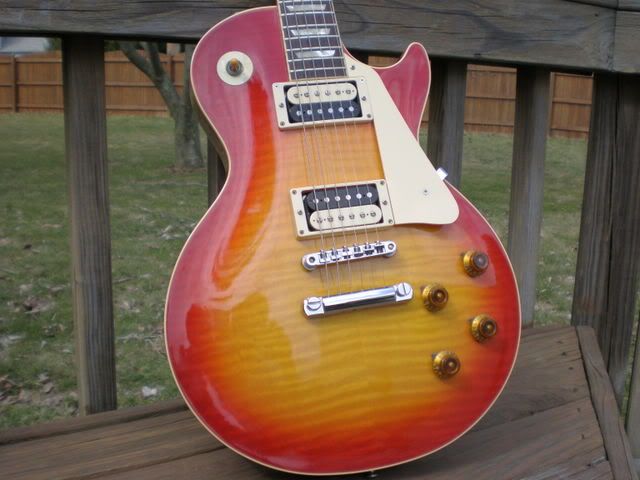BlueThird
Well-known member
Can anyone suggest a definitive method of identifying a 1983 Love Rock? Recently bought one that was advertised as an LS60, but from what I can work out it might be an LS80. In one sense it doesn't matter because it's a fantastic guitar and I'm not going to be selling it on; on the other I'd like to know. Trouble is, I've seen different sources that seem to contradict each other.
For example, the Registry suggests that an LS80 of that vintage would have an 18? headstock angle and Tokai PAF 57 pickups, as this one does, whereas an LS60 would have a 14? headstock and LS Vintage MkII exposed pickups.
Yet I've also seen a 1984 catalog which indicates the LS60 could also have an 18? headstock and PAF 57 pickups.
Anyway, the salient facts are these:
It's definitely a 1983 model, as indicated by the serial number (3014xxx), but assuming the serial numbers are sequential it's presumably from quite late in the year. Ageing on the hardware is similar to that on the Springy Sound ST80 that I've had for the past 25 years and which dates to 1980.
Marks and dings are consistent with a well-looked after guitar of that age, perhaps with some marks painted over on the back of the body.
Pickups are definitely PAF 57s with covers in place (and sound great).
Headstock is definitely 18?.
So far as I can tell, the back is one-piece, though it could possibly be three. Since it's painted black, it's very difficult to see any joins that might be there, but the grain (which can just be seen along the back) consistently runs a little off square right the way across the guitar. There are no joins to be seen in the pickup cavities.
I don't have sufficient knowledge to identify the finish, but can say that it seems more 'natural' than the finish on my ST80.
Though the pickguard, binding and selector switch plate are cream, the pickup mounts are black, perhaps suggesting that they've been replaced.
Any help would be much appreciated.
For example, the Registry suggests that an LS80 of that vintage would have an 18? headstock angle and Tokai PAF 57 pickups, as this one does, whereas an LS60 would have a 14? headstock and LS Vintage MkII exposed pickups.
Yet I've also seen a 1984 catalog which indicates the LS60 could also have an 18? headstock and PAF 57 pickups.
Anyway, the salient facts are these:
It's definitely a 1983 model, as indicated by the serial number (3014xxx), but assuming the serial numbers are sequential it's presumably from quite late in the year. Ageing on the hardware is similar to that on the Springy Sound ST80 that I've had for the past 25 years and which dates to 1980.
Marks and dings are consistent with a well-looked after guitar of that age, perhaps with some marks painted over on the back of the body.
Pickups are definitely PAF 57s with covers in place (and sound great).
Headstock is definitely 18?.
So far as I can tell, the back is one-piece, though it could possibly be three. Since it's painted black, it's very difficult to see any joins that might be there, but the grain (which can just be seen along the back) consistently runs a little off square right the way across the guitar. There are no joins to be seen in the pickup cavities.
I don't have sufficient knowledge to identify the finish, but can say that it seems more 'natural' than the finish on my ST80.
Though the pickguard, binding and selector switch plate are cream, the pickup mounts are black, perhaps suggesting that they've been replaced.
Any help would be much appreciated.














